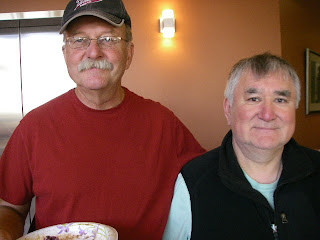Classes are given in language, basket weaving, regalia, drum making, traditional food preparation, hunting hat construction, kayak construction, dance and more.
A pictorial overview follows.
 Moses Dirks who hails from Atka was this year's instructor in traditional foods. Here he demonstrates how to fillet a salmon in preparation for air drying.
Moses Dirks who hails from Atka was this year's instructor in traditional foods. Here he demonstrates how to fillet a salmon in preparation for air drying.
And here are the students following his lead.
 Moses is also one of the few hundred Aleuts who still grew up speaking the Atkan dialect of Unangam Tunuu, the Aleut language. Moses helped with the Aleut pronunciation of kayak parts which Mike Livingston recorded. Moses is on the right and I am on the left with an empty plate heading back into the chow line for seconds.
Moses is also one of the few hundred Aleuts who still grew up speaking the Atkan dialect of Unangam Tunuu, the Aleut language. Moses helped with the Aleut pronunciation of kayak parts which Mike Livingston recorded. Moses is on the right and I am on the left with an empty plate heading back into the chow line for seconds.
Which is as good a point as any to introduce the pot luck put on on the last day of culture camp. People bring lots of goodies which anyone would recognize and also Alaskan favorites such as caribou, fish pie, smoked fish, fish soup, etc.
 Aleut women were noted for their fine weaving and basketry which employed specially dried and processed beach grass. Weaving went on inside the building and we were building kayaks outside so I didn't get a chance to take more pictures of the many creations. Next time.
Aleut women were noted for their fine weaving and basketry which employed specially dried and processed beach grass. Weaving went on inside the building and we were building kayaks outside so I didn't get a chance to take more pictures of the many creations. Next time. Kids learned traditional dances which they are putting on here before the big potluck in front of an appreciative audience.
Kids learned traditional dances which they are putting on here before the big potluck in front of an appreciative audience.
Older kids put on their dance outside on the lawn.

Back when Russia still controlled Alaska, they move some of the Aleuts to the Commander Islands to do the sea otter hunting there. When Russia sold Alaska to the US, the Commander Islands stayed under the control of the Russians. The Russians like the Americans had a policy of modernizing the natives and so, Aleut Culture went into a decline in Russia as it did in the US. Russian Aleuts now are trying to regain their culture and three representatives from Russia were here at the culture camp to see how American Aleuts were teaching traditional culture. In the photo above, two of the Russians on the right and Sally Swetzof one of the American instructors join in on singing a traditional Aleut song.

Younger children, besides learning dances and language also made paper versions of the traditional hunting hats. Each one was also given a traditional Aleut name which was written on a name tag which the photo shows them wearing.

Mask making, a traditional Aleut activity was not taught at the culture camp, but one of the older students improvised with a piece of discarded kayak skin.
 My own participation was in kayak making. This photo shows two baidarkas made by Mike Livingston and myself at last year's camp which now adorn the lobby of the APIA headquarters building.
My own participation was in kayak making. This photo shows two baidarkas made by Mike Livingston and myself at last year's camp which now adorn the lobby of the APIA headquarters building.
Future kayak builders were also in attendance. They were skeptical at first but after some persuasion, got into the act.


And I almost forgot the Native Youth Olympics. This year's champion in the high kick was on hand to demonstrate her skill. The object of this sport is to kick a ball suspended above the contestant's head. Due to lag time of my camera, I wasn't able to get it to click the shutter at the critical moment so you have to take my word that she did kick the ball.
1 comment:
Hi! I like your blog, it's beacuse I'm intersted in Aleut culture. Thank you for sharing informations about Aleuts and your impressions from Aleut culture camp. Please, Do you know any traditional Aleut food (Aleut name + description)? Thank you very much.
Best wishes from the Czech Republic ;)
Post a Comment